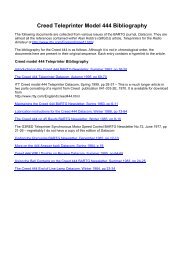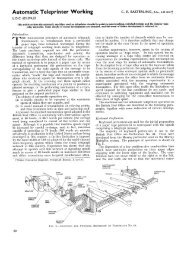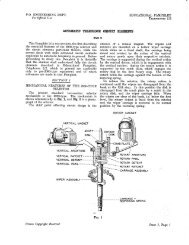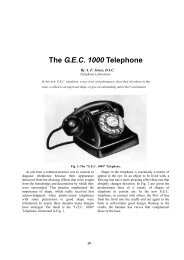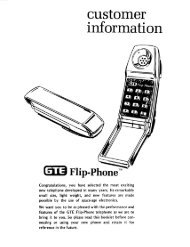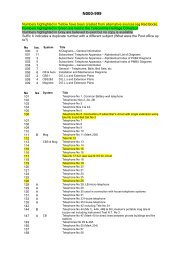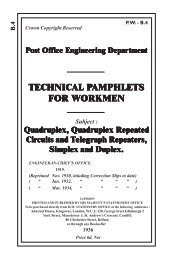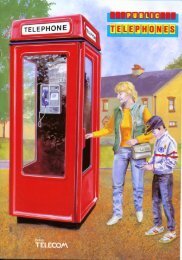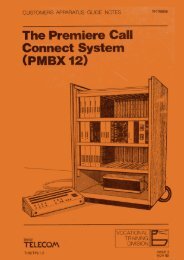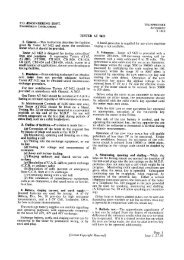TRAFFIC CONTROL TELEPHONE SYSTEMS Circuit - Sam Hallas
TRAFFIC CONTROL TELEPHONE SYSTEMS Circuit - Sam Hallas
TRAFFIC CONTROL TELEPHONE SYSTEMS Circuit - Sam Hallas
You also want an ePaper? Increase the reach of your titles
YUMPU automatically turns print PDFs into web optimized ePapers that Google loves.
normal, Relay IR is held operated and Relay DC (held over its 3 ohm winding)<br />
releases, as it will not hold in series with Relay G.<br />
When the Controller restores his dial key, Relay IR releases and completes a<br />
circuit for the operation of Relay LC via 50 volt negative, Relay LC e-a winding, IR2,<br />
DC3, bank contact of line switch SB2, G2, GC3, TS2 to 50 volt positive. Relay G<br />
releases after the opening of IR1 the short circuit delaying its release sufficiently to<br />
permit the operation of Relay LC as described above. When G2 opens, Relay DS<br />
releases, but Relay LC remains operated over LC5, line switch SC banks 3 and 4<br />
wiper arms to 50 volt positive. Relay BR operates at LC 4 and connects the impulsing<br />
battery to the line as follows :<br />
Line Battery negative, resistor YN and YM, CB3, CB2 circuit breaker (CB) trip<br />
coil 2 ohm winding, SR3, smoothing chokes A and B, BR2 to Line 2. Line battery<br />
positive, SRI, smoothing chokes A and B, BR4, to Line 1. Relay SD operates via 50<br />
volt negative Relay SD, line switch SC drive contacts, line switch SC wiper arms 1<br />
and 2, LC2, to 50 volt positive. Relay SD completes the driving circuit for line switch<br />
SC at SDI, via line switch SC wiper arms 1 and 2, and LC2. Line switch SC drive<br />
contacts open the circuit for Relay SD, when the magnet is fully energised. Relay SD<br />
releases, and at SD opens the driving magnet circuit of line switch SC, and the switch<br />
takes one step when the magnet releases. The drive contacts SC, remake contact<br />
when SC magnet releases, and Relay SD again operates via SC wiper arm and bank<br />
contacts 1 and 2 to 50 volt positive.<br />
This cycle of operations between Relay SD and the driving magnet of line<br />
switch SC, will continue until Relay LC has released and wiper SCI is stepped round<br />
until it reaches its normal (home) contact.<br />
Relay SD is in parallel with a rheostat and by adjusting this rheostat, the release<br />
time of Relay SD can be varied until line switch SC steps at the correct speed. As the<br />
wipers of line switch SC step round, there is a short preparatory period until SC<br />
wipers 5/6 reach SC bank contacts 5, when Relay IS will be operated via 50 volt<br />
negative, resistor YF. Relay IS winding, SC wipers 5/6, SC bank contacts 5, to 50 volt<br />
positive. Ignoring, for the moment, any 50 volt positive connections applied to the<br />
bank contacts of line switch SC by banks 3 and 4 of line switches SA and SB, it will<br />
be seen that on each alternate step of line switch SC, Relay IS will be operated until<br />
it has completed 25 operations and line switch SC reaches its home position.<br />
Page 43



